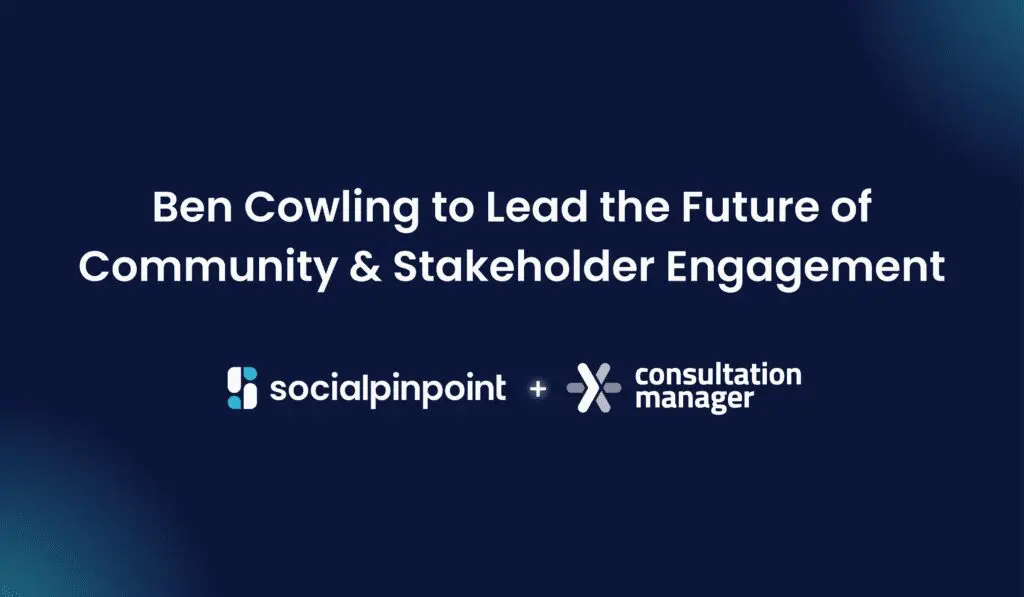Imagine yourself sitting in a town hall meeting discussing the latest traffic project in the city.
An individual stands up and angrily expresses their opinion about a problem, but you don’t necessarily agree with them. You might not be alone either. That angry member of the community might only represent a small percentage of the community, yet that member may be some of the only feedback the city receives on the project.
But what about the other 95% of community members who don’t agree, are too shy to speak up or aren’t in attendance of town hall meetings?
Now, imagine yourself as a communications and engagement professional trying to gather the insights and opinions of stakeholders on a particular development or community issue. How do you ensure the majority of the community are able to have their say, and you are not alienating a majority of the community that may not present at meetings?
There has always been a slight problem with traditional offline community engagement methods. For example, meeting face-to-face with local community groups, or a kiosk at a local shopping center to gain community insight. In addition to the fact that these methods require significant resources, time and expenses; it is usually the same profile of person attending and may not be an accurate representation of the entire community.
The emergence of online, social engagement tools over the past few years has been very exciting. According to Smart Insights latest marketing statistics, as of January 2017, there are an estimated 3.7 billion internet users and an estimated 2.7 billion social media users around the world. These media networks are now so well-established and within a wide demographic range that will only continue to grow – a perfect place to reach out to a higher percentage of the community.
Are you enjoying this article?
Access our free Infographics Library on all things engagement.
Connecting to a community and stakeholders online gives you more reach, allowing a higher participation rate from a broader audience for a fraction of the cost and convenience. These include fancy dashboards, real-time statistics and reports allowing you to establish results and data to management for both positive and negative results to continually improve your relationship with the community.
So, problem solved! Right? No more having to spend hours at a booth at the local shopping center asking for insight. Gone are the days where you need to stand up at the front and defend your plan to that angry person waving their fists at you. You can go ahead and set up a quick website, throw in some marketing and watch the feedback roll in – management is going to love the pretty dashboards.
Unfortunately not. Online engagement is a great tool, but it will never fully replace offline engagement.
If you solely rely on online communication, you will exclude certain individuals or groups in the community. Not everyone can gain access to online facilities, or want to engage at all online. Taking this into consideration is critical for engagement success.
The importance of community engagement is not to alienate any particular group or demographic – but to get everyone involved in various ways.
It’s important to meet in the middle with those members that rely on offline engagement. You can’t often replace the direct concern of seeing their facial expressions and genuinely listening to their problems.
The truth will remain that the best way to deal with the angry person in attendance to a town hall meeting is directly face-to-face. Ultimately, you can use offline engagement to complement online engagement by effectively reaching out to a broader cross-section of the community. Another factor to take into consideration is your target demographic for the project.
Despite the bad news of not getting out of the town hall meeting, the good news is that you can support it with online tools. You may still have to deal with the small numbers that want to talk face-to-face, but now you can reach further at a time or place of their convenience, and allows you to be in touch with more members of the community more often. You can utilize online engagement by incorporating surveys or creating an ideas wall, that encourages the public to get involved. They can then discuss and come up with solutions while communicating with other members, instead of stating only problems at meetings.
According to a study done on a government project, it is proven that a mixed participation model of both online & offline communication works best, in order to benefit the most from citizen engagement. Some topics that were taken into account were the target audience, time frame, exchange of constructive ideas, educational approach and problems – things you could delve more into with an online engagement plan.
To sum it all up, offline and online engagement are both equally important components of your strategy.
One should never replace the other since each offers important elements. Creating a plan where offline and online engagement tools compliment each other in a way that suits your community and stakeholders effectively to reach a broad audience will ultimately lead to the best result for your project and the community.
Further Reading
Opera, Radu Adrian., & Sarpe Ancuta Daniels. (2009, November 14-15th). Online vs. Offline vs. Mixed Participation for Better Governmental Policy-Making. ICEA – FAA Bucharest. Retrieved May 15, 2017, from http://public-policies.eu/uploads/Online_vs_Offline_vs_Mixed_Participation.pdf.
Chaffey, David. (2017, February 27th). Global social media research summary 2017. Smart Insights. Retrieved May 15, 2017, from http://www.smartinsights.com/social-media-marketing/social-media-strategy/new-global-social-media-research/.












